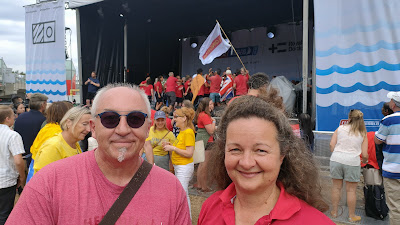In the summer of 2019 I saw the Clipper Race depart from St Katherine's Dock in London. One pandemic, one war and three years later it was finally the time to welcome them back so I flew to London for the Race Finish.
The first stop was a meet-up for the 2023-24 crew that the Clipper Race team organised. It was held in the basement of The Fox pub at the Excel complex, near the Royal Docks. We had a lot of fun and I was able to mingle with a lot of the people doing the next race, including Alan, Claire, Paul, Simon, Brian, Sophia, Lucy and many others. Many of them knew about me because I have been very active in our Facebook group page. The questions that everyone was asking were "what legs are you doing?" and "have you done any training?". A lot of the people were round-the-worlders and most people were doing at least a couple of legs, I spoke with very few people who were doing only one leg. And no one seemed to be doing the particular combination that I have chosen, legs 2 and 3.
During the meeting I also learned that I was not the only one to be a fool and get a hotel near St Katherine's docks, expecting the race to return there. The race returned to the Royal Docks which are a bit further East, near the Excel complex. When you compare this new location to St Katherine's you can see that it is much less glamorous, located in a not very beautiful space, far from everything and not very convenient so I would have much preferred to see them going back to the old spot. Also, you don't get the boats to pass under the iconic Tower Bridge. And it would have saved me a 40 min bus + DLR journey :-)
So next day I met a friend at the Royal Docks around 12:00 when all the festivities began. We took a walk around the compound looking at all the info displayed and speaking with some of the Clipper Race crew. Sir Robin was walking around, talking to seemingly "important" people. And I also saw some of the people that I had met the day before.
The ships were supposed to be there around 1:30pm but they did not finally appear until around 2:30pm. We learned that the Imagine Your Korea yacht had had to stop in Ipswich because they were vey late and would not have been able to reach the Royal Docks in time for the prize giving. Since the ships departed Derry last Sunday I was worried that the time available to get to London was too short and unfortunately that happened to be the case :-(
The parade of sail was really beautiful, the yachts did a couple of rounds passing quite near to the docks, with everyone cheering and applauding. It was a great experience and I loved to see them celebrate their arrival into their final destination. Most crews seemed really happy and celebrating, a few were a bit more subdued. It must have been a really emotional moment for them.
Then it was time to dock and it took them a while because there was not enough space for all of them to be dockside so they had to dock in two rows side by side and it was a bit complicated. All the while you could see very happy reunions, people embracing and a lot of celebration going on.
Finally it was the time for prize giving and all the teams walked up near the stage. Sir Robin took the stage and said a few words and then the teams all took the stage one by one, starting with the last one in the classification and ending with Qingdao, the winners. The played each team's chosen music as they climbed into the stage and there was a lot of celebrating, including champagne showers! I was glad to see that the Imagine your Korea team was able to make it to the ceremony even if they had had to leave their boat in Ipswich. You could see that some teams were really happy, jumping around, shouting and having tonnes of fun. Others seemed more subdued, happy but not so exuberant. I want to be part of one of the "happy" teams, jump, shout and celebrate!
It was specially great to be able to see the Punta del Este team, which I had been supporting, take their second place. You could feel their energy and happiness and we had a blast, including everyone singing "Oe, oe, oeeee" and "Vamos Punta!!". I loved it.
During the ceremony I suddenly met Jackie, our first mate from my Skirr Adventures trip at the beginning of the month. She had come to London to see the Race Finish and was going back to Scotland that same day. It was great to see her again!
After prize giving I was able to chat for some minutes with Jeronimo, the skipper of Punta del Este and congratulate him for the great performance of their team. He is Spanish and comes from the same region where I live, so we both had great fun exchanging information. He told me that my choice of doing legs 2 and 3 was great and to prepare for something extraordinary, specially in leg 3. You could tell that he felt very proud about what him and his team had achieved.
And now that the 2019-20/22 race is fully over it is finally OUR time. The "current" race is now the 2023-24 race and there is just a little over a year before our adventure really begins. Everyone told me that the time would really fly now and we would all soon been enjoying this experience that we have all been looking forward to for so long. Can't wait!!

















